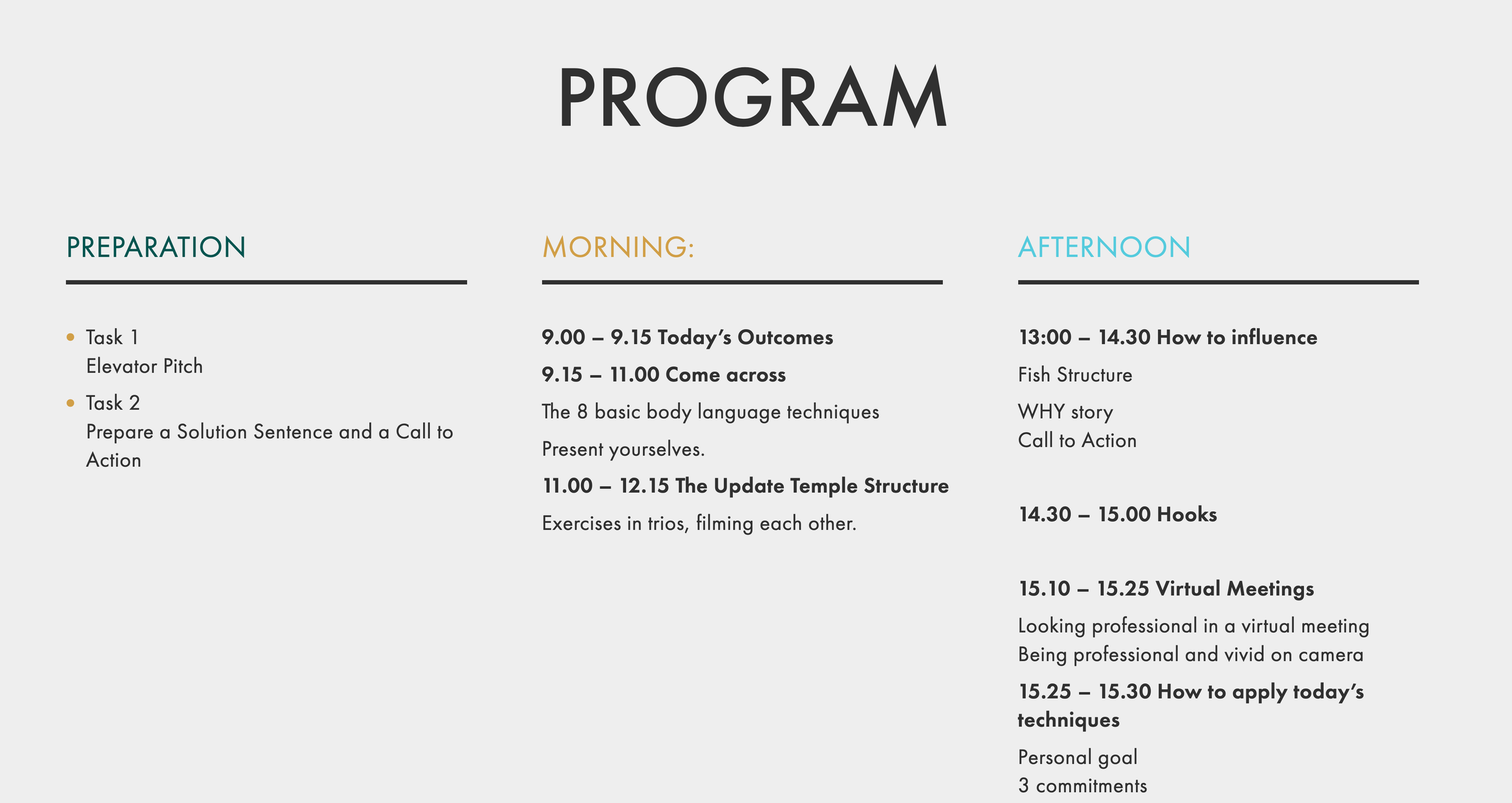Instructor:
Lene Kobbernagel
I strive to get people heard and understood.
Presenting with Confidence Classroom Course
Hi there,
I am thrilled to have you onboard this Classroom Training Course in Presenting with Confidence.
Here you will find the prework and all material linked to this course.
Have fun with it
Lene
Prework
Task 1: Personal Elevator Pitch
PREPARE A SHORT INTRODUCTION OF YOURSELF
Almost all presentations start with a personal introduction. But what should you say to make the right impression, leaving the audience trusting you both professionally and personally? Here is the recipe for a “personal elevator pitch”, which you can use as inspiration for delivering a short personal introduction.
THE RECIPE
NAME, TITLE and NUMBER of years in the business.
WHY: Formulate a short sentence describing your WHY, meaning the difference you were put in the world to make.
Example: I’m driven by optimising processes.HOW: Formulate a short sentence describing your most important ability/competency in your quest to realise your WHY.
Example: I do that by… / I take pride in… / I do all that I can to simplify/analyse / keep up to date with / be curious about …WHAT: Give a concrete example of a result you’ve just achieved on behalf of a prominent client (name dropping welcomed).
Example: I recently counselled XX to do YY, which resulted in ZZ.MOTTO: Your personal motto – it should say something about your way of working or thinking.
Example: My motto comes from Benjamin Franklin, who said: “Investment in knowledge pays the best interest”. I believe that, which is why …
EXAMPLE
My name is Ian. I’m an investment advisor with 20 years of experience. The most important aspect of my job is to try and make my clients think bigger. To always think long-term in their decision making. So I always keep up to date on long term trends. Last month I advised xx to do yy, which resulted in … My personal motto is: “Whatever you’re thinking, think bigger” – and that’s what I do: make my clients think bigger.
Task 2:
Think of a message and formulate the “Solution Sentence” , the Call-to-Action and the Reward
What is your solution about? Formulate this in one sentence.
For Example: To use a Power App. or To reorganise our team, or “To optimise lead-time”.
Call to Action
What does it take – in a very concrete sense — to turn your solution into reality?
Formulate the first three concrete actions that people can do in near future to succeed with your message.
EXAMPLE: If your message is to implement a new IT-system, your Call-to-Action might be:
ONE: Use the new system for a minimum of ten minutes every day
TWO: Participate in one workshop on the new IT-system
THREE: Talk to a colleague about your experiences with the system
REWARD: That way we will all onboard together - and reduce frustration. We’ll celebrate it with a nice dinner.
Which three actions would kick-start the implementation of your message?
What will they get out of it?
FILL THIS OUT
To succeed with { goal }, the first concrete things we need to do are:
___________________________________________________________________
__________________________________________________________________
__________________________________________________________________
What’s the reward? What’s in it for them?
_______________________________________
Example
To succeed with collaborating across disciplines, let’s:
Involve everyone in making a concrete plan
Adjust the concrete plan as-we-go based on experiences
Have more conversations about our strategy and our work
That way we’ll make each other more happy
Reward: This way we can maintain the tempo and consistently reach our daily deadlines.
That’s it. See you soon:)
All the best,
Lene
- Below there is a series of videos demonstrating the techniques we are going to train when we meet. You are welcome to browse. But it might be better to wail till after our class.
After the Class Room Training
| Commit yourself to three things after the class :) | No | Yes |
|---|---|---|
| I will speak in Corridors - one sentence = one corridor | ||
| I will present from the I-posture with lower body firmly grouded | ||
| I will use hands to serve sentences to look confident | ||
| I will use my hands to place topics in my surrounding space | ||
| I will use Rule of 3, and use my fingers to illustrate the 3 points | ||
| I will use the S body posture to come across as warm and informal | ||
| I will use pauses after each meaning sequence: Say “Can you follow me?” Tacitly in your head | ||
| I will use WHY Stories: We are currently in a situation, and we strive to… , BUT unfortunately…. And the consequence is | ||
| I will speak in lists and use hands to place list items on shelves or with bowling balls | ||
| I will end with a Call to Action using 3 fingers to illustrate each action | ||
| I will use an involvement activity to grab attention in the opening |
Slides
Download the slides (pdf).




